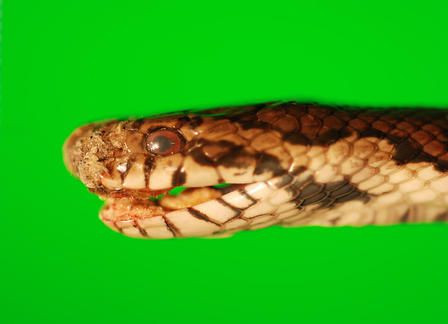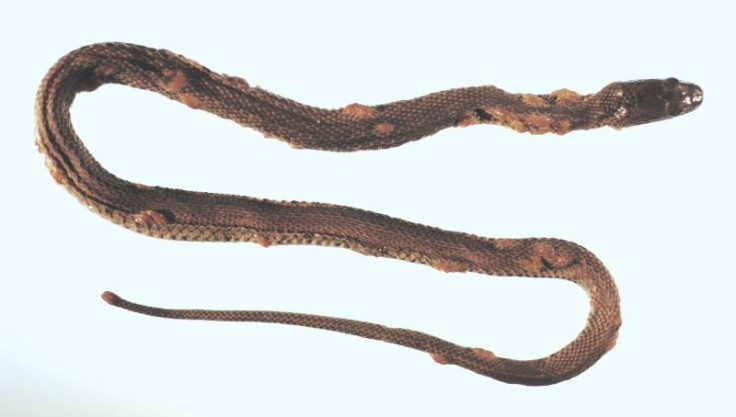Will Snakes Disappear From Earth? Lethal Fungal Disease Spreading Fast, Hits Europe

Snakes are intertwined in our history and served as figures that possessed a cunning, almost sinister persona. Theory suggests the Satan disguised himself as a snake to trick Eve into biting into the forbidden fruit, forcing her to sin. But, we’ve grown to understand these slithering reptiles and some of us even have them as pets now.
Now, a lethal fungal infection that affects snakes has spread to Europe from the U.S. and puts the life of snakes worldwide in jeopardy. This fatal disease has already affected several species and scientists say that its rate of transfer and lethality across species could spell disaster to snake population worldwide.
A new study has shown that the fungal disease caused by a bacteria called Ophidiomyces ophidiodiicola can infect snakes of many species regardless of their ancestry, physical characteristics, or habitats. Now that it has spread to Europe, it has the potential of being catastrophic globally.
The study published in journal Science Advances on Dec. 20 said no species was immune to the fungal disease found already in wild species such as garter snakes, milk snakes, and vipers in the eastern United States, as well as three species in Europe.
The study's authors include researchers from the American Museum of Natural History (AMNH), the U.S. Geological Survey, and the University of Maryland, College Park.
"This really is the worst-case scenario," said Frank Burbrink, an associate curator in the Museum's Department of Herpetology and the lead author of the publication in a press release on the AMNH website. "Our study suggests that first responders shouldn't just be looking for certain types of snakes that have this disease, but at the whole community. All snakes could become infected, or already are infected."
Nearly 23 species have been affected in the U.S. already and three more have been added to the list since it started spreading.
The disease primarily affects snakes' skin. Small bumps and crack start forming in the infected area which slowly becomes lesions. Some snakes get lucky and can just shed the infected skin off but most don ’t. These lesions spread quickly and can cover a large part of the body within days.
The researchers say that, in an attempt to get rid of the infected skin, which could cause itching, snakes start basking in the sun for long periods. This keeps them exposed to most parts of the day and are hunted by birds or other predators that feast on snakes. Some even end up forgetting to eat in their efforts to get rid of the skin.
"Some of the most devastating wildlife diseases ever documented, such as white-nose syndrome in bats and chytridiomycosis in amphibians, are caused by fungal pathogens," said Jeffrey Lorch, a microbiologist with the U.S. Geological Survey (USGS) National Wildlife Health Center. "These diseases have had such great impacts because they affect multiple species, and it now looks like the same is true of snake fungal disease."
A close study of these species provided the team with this scary news. Snakes, like all animals, help maintain a balance in the ecosystem. Their population can cause an explosion in the number of rats in the U.S. as lesser will be hunted down by snakes. In a world with no snakes, there will be fast changes in our ecosystem.

The study analyzed the traits using a neural network to look for associations that could be used to predict which species of snakes might be susceptible to the disease. Results showed that hosts for snake fungal disease were randomly dispersed among the data.
Based on the findings of the study, every snake species on Earth could be could be susceptible, and that the visible population decline observed in the Western U.S. will just extend globally unless measures are taken.
"The data for our model may not be perfect, but it will tell you if there's even a weak association between a characteristic--for example, eating a certain type of animal or living in a particular environment--and the potential to get this disease," Burbrink said. "And in this study, our model found no association other than 'you are a snake.'"
The team feels that the government must step in as only people capable of causing an overnight change in the form of laws and efforts to isolate and treat infected snakes in the wild.
"Scientists have learned a lot about research and monitoring needs from 25 years of studying the effects of chytrid fungi on amphibians, and those lessons tell us that prevention is the best policy," said Karen Lips, a professor of biology at the University of Maryland, College Park in a Phys.org report. "Researchers need to work with decision makers to prevent snake fungal disease from spreading, survey museums and field sites to determine the current distribution of the disease, run trials in the lab, and start working on treatments."
Teams of researchers and governments must work together to stop this fast spreading disease reaching other countries. Asia and Australia have a high density of snakes and a full-blown epidemic could prove disastrous.
© Copyright IBTimes 2024. All rights reserved.




















